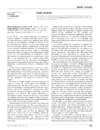issue contents
April 2006 issue

Cover illustration: A small molecule inhibitor at the active site of E. coli methionine aminopeptidase. This inhibitor shows remarkable selectivity towards the MnII-form of the enzyme (p. 425). MnII ions are the two partially exposed green spheres.
research papers
Hen egg-white lysozyme has been crystallized in a hexagonal crystal form and the structure of this crystal form has been determined to 1.46 Å resolution.
PDB reference: hexagonal hen egg-white lysozyme, 2fbb, r2fbbsf
The structure of T. reesei hydrophobin HFBII is described to an ultrahigh resolution of 0.75 Å. The structure has been carefully analyzed and comparison is made to a previously published atomic resolution structure of the same protein as well as to other ultrahigh-resolution protein structures found in the PDB.
PDB reference: T. reesei hydrophobin HFBII, 2b97, r2b97sf
When a strict sampling handling protocol is respected, low-temperature absorption spectra of three-dimensional bR crystals, grown in lipidic cubic phase, are almost identical to those obtained for purple membrane. Slight changes of the crystal hydration lead to drastic and irreversible modifications of the spectrum that are to be avoided in the context of high-resolution crystallography.
The crystal-to-crystal phase transition of monoclinic hen egg-white lysozyme mediated by dehydration proceeds by way of an intermediate state containing two types of microcrystals: original and transformed. The enhancement of the diffraction power of the transformed crystal is mostly ascribable to the suppression of rigid-body motion in the densely packed crystal.
The crystal structure of an FMN reductase has been determined by sulfur-SAD. The structure of the complex with the cofactor FMN is also presented.
The paper reports the crystal structure of triple mutant (K53,56,121M) phospholipase A2 complexed with the inhibitor anisic acid.
PDB reference: K53,56,121M PLA2–anisic acid complex, 2b96, r2b96sf
A method has been developed to obtain candidate conformations of multidomain proteins for use in molecular replacement. After obtaining the relative rotation between domains, iterative normal-mode analysis was used to drive the template structure near to the target conformation.
The structure of the complex formed between phospholipase A2 (PLA2) and diclofenac revealed the substrate-binding site of PLA2 to be physically blocked by diclofenac with a strong affinity, making several interactions with the enzyme. Surface plasmon studies indicated a value of 4.8 × 10−8 M for the dissociation constant (Kd).
PDB reference: phospholipase A2–diclofenac complex, 2b17
An echinomycin–DNA complex was solved by SAD phasing with the help of an unexpected cation; the structure provides the first crystallographic evidence for the presence of both Hoogsteen and Watson–Crick base pairs flanking the chromophores of the bisintercalating antibiotic.
PDB reference: echinomycin–(ACGTACGT)2 complex, 2adw, r2adwsf
Three crystal structures of E. coli methionine aminopeptidase, two in the MnII form and one in the CoII form, complexed with metalloform-selective inhibitors provide the structural basis for their metalloform-selective inhibition.
A new packing motif of elongation factor Tu was determined from a twinned and mosaic crystal.
PDB reference: Escherichia coli elongation factor Tu, 2fx3, r12fx3sf
The TLSMD algorithm finds an optimal multi-group TLS (translation/libration/screw) description of a protein as seen in a single crystal structure. This description is an approximation to intrinsic dynamic properties of the protein such as interdomain motion and local flexibility. TLSMD-generated models can improve crystallographic refinement and can offer insight into biologically relevant dynamic properties of the protein.
A simple and rapid high-throughput screen for determining relative stabilities of proteins has been developed and specific application to membrane proteins is demonstrated.
The X-ray crystal structure of human TSG101 UEV domain has been determined at 2.2 Å resolution and refined to an R factor of 18.8%.
PDB reference: human TSG101 UEV domain, 2f0r, r2f0rsf
book reviews
Free 



 journal menu
journal menu


































